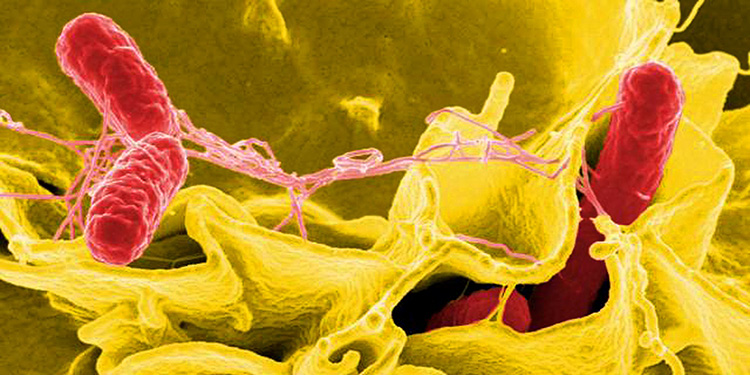After Escherichia coli, Salmonella might be one of the world’s most recognized bacterial species. Outbreaks of Salmonella have occurred in several food products including the well-known peanut butter outbreak in 2009 in which 714 people in 46 states became ill and 9 deaths were reported. This outbreak was caused by a strain of Salmonella Typhimurium.4 A more recent outbreak was reported in 2015 when contaminated cucumbers were imported from Mexico. This Salmonella outbreak resulted in 907 infections throughout 40 states and 6 deaths were reported.7
According to the Centers for Disease Control and Prevention (CDC), Salmonellosis is estimated to cause more than 1.2 million illnesses and around 450 deaths annually in the United States.1 Salmonella infections most often cause gastroenteritis, which includes symptoms such as nausea, vomiting, abdominal cramps, diarrhea, fever and chills. More serious complications can occur if the infection spreads beyond the intestines. Symptoms typically begin within 3 to 72 hours, and most healthy adults recover within a few days.2 Proper hand washing and food handling is key to preventing a Salmonella infection.
When we think of Salmonella infections, we often think of raw eggs and chicken. While eggs and chicken are a possible cause for Salmonella infections, there are a number of other causes. Meat, poultry, eggs and even fruits and vegetables can be contaminated with Salmonella. This is why proper hand washing and food handling is so important. Some pets can also be carriers of Salmonella which is found in their feces. Reptiles, baby chickens and ducklings are all common carriers of Salmonella. People should wash their hands after handling these animals.5
Salmonella strains are classified by serotypes. There are many different serotypes and each has a unique story. Serotypes differ in surface structure, characteristics, how they infect their hosts and what sources they typically contaminate. The CDC currently classifies 32 individual Salmonella serotypes. Surveillance data on these 32 serotypes of Salmonella across the United States can be found in the CDC Atlas of Salmonella .3
Salmonella might be one of the more complex systems due to the vast number of strains. All Salmonella strains are gram-negative bacilli that fall under the Enterobacteriaceae family. There are two species of Salmonella: S. enterica and S. bongori. S. enterica is comprised of six subspecies:
- enterica subsp. enterica
- enterica subsp. salamae
- enterica subsp. arizonae
- enterica subsp. diarizonae
- enterica subsp. indica
- enterica subsp. houtenae
Each subspecies is divided into serovars. Only subspecies 1 is associated with disease in warm-blooded animals. Approximately 50% of human Salmonella infections are caused by the serovars Typhimurium, Enteritidis, and Newport which all fall under S. enterica subsp. enterica.6 However, there are over 2,300 serovars within the subspecies enterica.6 Serotyping is used to link cases of illness with similar bacteria and to pinpoint the source of the contamination. Some serotypes are only found in a specific place or one type of animal, and others are found in many places and animals all over the world. They can be distinguished using laboratory tests because of the distinct combination of antigens that make up the serotypes’ surface structures.
Is your laboratory looking for controls to ensure you can detect Salmonella using your methods? Microbiologics offers 34 different strains of Salmonella in a variety of formats including UV-BioTAG™ – QC microorganisms with green fluorescent protein (GFP) markers. Visit our website to find the right strain and format for your lab
References:
1 Snapshots of Salmonella Serotypes (2015)
https://www.cdc.gov/salmonella/reportspubs/salmonella-atlas/serotype-snapshots.html
2 May Clinic – Salmonella Infections (2017)
https://www.mayoclinic.org/diseases-conditions/salmonella/symptoms-causes/syc-20355329
3 An Atlas of Salmonella in the United States, 1968-2011
https://www.cdc.gov/salmonella/pdf/salmonella-atlas-508c.pdf
4 Multistate Outbreak of Salmonella Typhimurium Infections Linked to Peanut Butter, 2008-2009
https://www.cdc.gov/salmonella/2009/peanut-butter-2008-2009.html
5Minnesota Department of Health, Causes and Symptoms of Salmonellosis (2015)
http://www.health.state.mn.us/divs/idepc/diseases/salmonellosis/basics.html
6NCBI Characterization of Salmonella enterica Subspecies I Genovars by Use of Microarrays
https://www.ncbi.nlm.nih.gov/pmc/articles/PMC516822/
7Multistate Outbreak of Salmonella Poona Infections Linked to Imported Cucumbers






Is their a strain of Salmonella that is immune to antibiotic therapy ?
Michael – There are a few antibiotic resistant strains: Salmonella enterica subsp. enterica (e.g. Kauffmann and Edwards) Le Minor and Popoff serovar Typhimurium (ATCC 35988) and Salmonella enterica subsp. enterica (e.g. Kauffmann and Edwards) Le Minor and Popoff serovar Enteritidis (ATCC 31194).